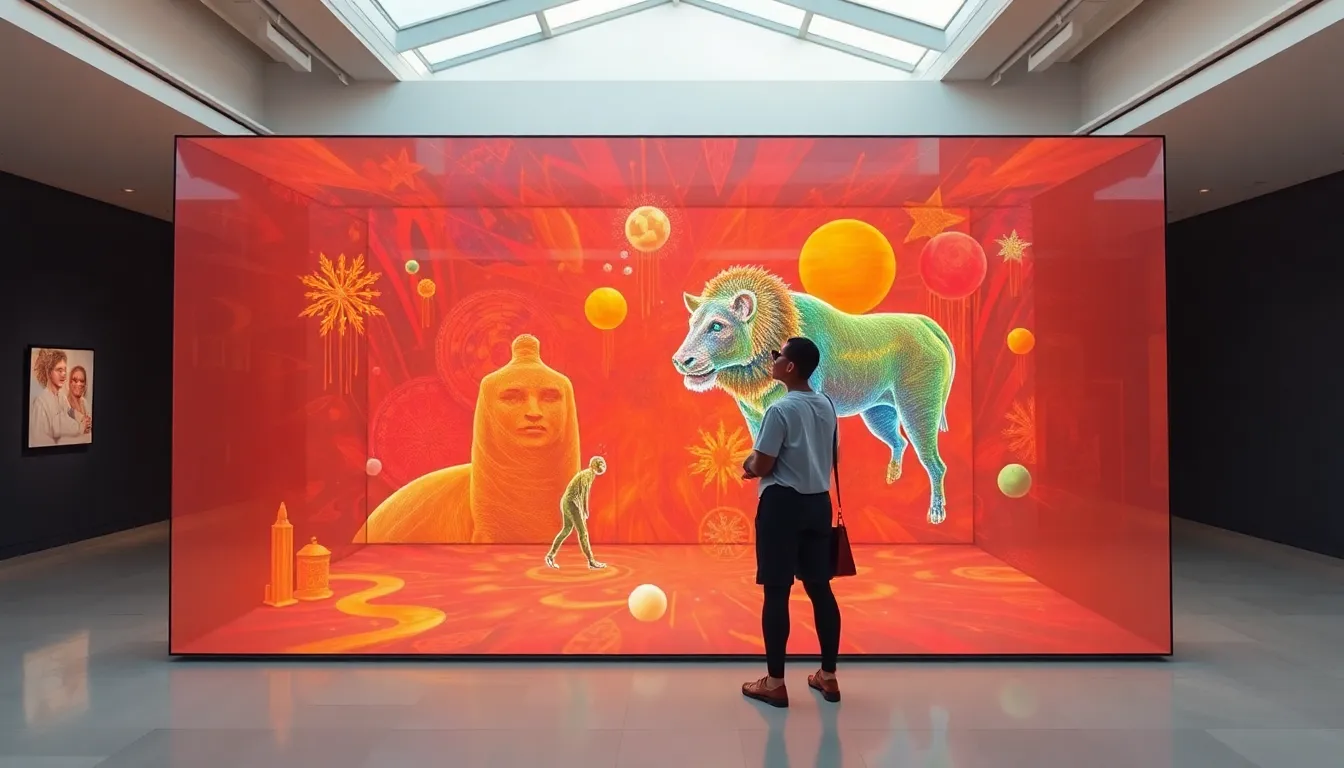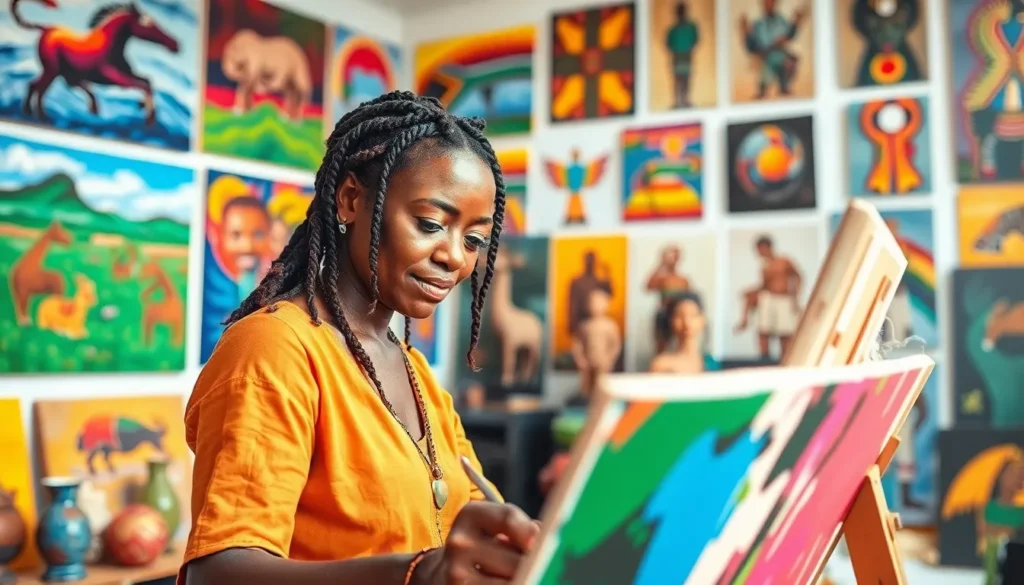South Africa boasts a vibrant artistic landscape that reflects its rich cultural heritage and diverse influences. From traditional crafts to contemporary expressions, South African artists continually push boundaries, showcasing their unique perspectives and stories. This dynamic scene not only captivates local audiences but also garners international attention, highlighting the country’s creative prowess.
Amid this thriving environment, Information ArcyArt emerges as a vital platform that connects artists with art enthusiasts. By providing insights into the works and backgrounds of various South African creators, it fosters appreciation and understanding of their contributions. This article delves into the fascinating world of South African artists and the role of Information ArcyArt in promoting their incredible talents.
Table of Contents
ToggleOverview of South African Artists
South African artists reflect the nation’s diverse cultural heritage through their unique expressions. They often draw inspiration from historical events, social issues, and personal experiences. Traditional forms, such as beadwork, pottery, and sculpture, coexist with contemporary practices like painting, photography, and digital art.
Notable artists include:
- William Kentridge: Known for his animated films and charcoal drawings, Kentridge addresses themes of memory and history.
- David Goldblatt: A prominent photographer, Goldblatt’s work documents social issues and the complexities of life under apartheid.
- Mary Sibande: Sibande explores identity and gender through her sculptural works that emphasize African womanhood.
- Candice Breitz: Breitz focuses on video art and installations, often critiquing popular culture and representation.
These artists contribute to a vibrant art ecosystem, participating in exhibitions both nationally and internationally. Their works often resonate with audiences due to their emotional depth and social relevance. Information ArcyArt plays a vital role in promoting these talents, providing resources and platforms for artists to reach wider audiences.
The Emergence of Information Arcyart

Information Arcyart represents a dynamic intersection of art and technology, showcasing the innovative expressions of South African artists. This movement not only amplifies voices within the art community but also redefines how audiences engage with art.
Definition and Key Concepts
Information Arcyart refers to a contemporary art movement that integrates information technology with artistic practice. It emphasizes digital mediums, interactive installations, and data-driven artworks, expanding the boundaries of traditional art forms. Key concepts include:
- Interactivity: Artworks often involve audience participation, allowing viewers to influence the interpretation or presentation of the piece.
- Data Visualization: Artists utilize data to convey complex themes, transforming raw information into compelling visual narratives.
- Multimedia Integration: This approach combines various media—such as video, sound, and digital graphics—to create immersive experiences.
- Accessibility: Arcyart promotes inclusivity by leveraging online platforms that reach a global audience.
The Role of Technology in Arcyart
Technology plays a pivotal role in the evolution of Arcyart, shaping both the creation and dissemination of artworks. Technological advancements facilitate novel creative processes and enhance audience engagement. Key aspects include:
- Digital Platforms: Artists showcase their work online through virtual galleries, social media, and art marketplaces, reaching wider audiences without geographical limitations.
- Augmented Reality (AR): Use of AR in installations creates interactive experiences that transform viewers’ perspectives, allowing them to explore art in new dimensions.
- Artificial Intelligence (AI): AI assists artists in generating unique artworks and exploring new creative methodologies, pushing the boundaries of human and machine collaboration.
- Online Collaborations: Digital tools enable artists to collaborate across borders, resulting in innovative pieces that reflect diverse influences and shared narratives.
Through these elements, Information Arcyart emerges as a transformative force in South African art, enriching cultural dialogue and inspiring new generations of artists.
Prominent South African Artists in the Arcyart Scene
South Africa boasts a roster of influential artists who actively contribute to the Arcyart movement, blending creativity with technology. Their works resonate on multiple levels, impacting both local and global art communities.
Artist Profiles and Their Works
- William Kentridge: Kentridge’s animated films and charcoal drawings delve into themes of memory and history. His multi-faceted approach often merges theater and visual art, engaging audiences through profound narratives that reflect South Africa’s past.
- David Goldblatt: Goldblatt is renowned for his impactful photography that captures social issues during apartheid. His meticulous documentation of everyday life provides a stark visual commentary on the complexities of South African society and its evolution.
- Mary Sibande: Sibande’s sculptural works explore identity and gender. By utilizing domestic materials, she critiques social norms while celebrating the strength and resilience of women in contemporary South Africa.
- Candice Breitz: Breitz creates video art that critiques popular culture and society. Her immersive installations challenge viewers’ perceptions and invoke dialogues about representation and identity, often utilizing celebrity culture as a thematic anchor.
Impact on Local and Global Art Communities
South African artists make significant contributions to both local and global art circles, encouraging cultural exchange and dialogue. Their works often address critical issues such as social justice, identity, and historical context.
- Cultural Representation: These artists bring South African narratives to the forefront, fostering a deeper understanding of the nation’s diverse cultural heritage across international platforms.
- Collaborative Projects: Artists engage in collaborations that transcend geographical boundaries, utilizing technology to create interactive experiences. These initiatives reach wider audiences, bridging gaps between different art forms and styles.
- Innovative Techniques: The integration of technology in their artistic processes not only redefines traditional art but also inspires new artistic movements. Artists leverage digital platforms, enabling innovative storytelling that resonates with contemporary audiences.
Through their distinctive approaches, South African artists enrich the global art scene, establishing a crucial presence while promoting the distinctive voices within the Arcyart movement.
Trends and Themes in South African Arcyart
Trends in South African Arcyart reveal a dynamic interplay between technology and traditional artistic practices. Artists engage with contemporary issues such as identity, history, and social justice, reflecting the complexities of South African society.
Key Themes
- Identity Exploration: Many artists focus on personal and collective identities. Works often depict the diverse cultural backgrounds and histories that shape individual experiences. For instance, the sculptures of Mary Sibande delve into gender identity and heritage, challenging societal norms.
- Historical Reflection: Artists frequently draw inspiration from South Africa’s past, particularly apartheid and its lingering effects. William Kentridge’s animations engage with historical narratives, emphasizing memory and trauma. His works foster dialogue about the nation’s history, prompting viewers to reflect on the past’s relevance today.
- Social Commentary: The engagement with social issues remains central within Arcyart. David Goldblatt’s photography documents the stark realities of life during and after apartheid, offering critical insights into ongoing social justice issues. His work highlights the power of visual storytelling in addressing complex topics.
Technological Integration
- Interactive Art: The use of interactivity characterizes many contemporary pieces within the Arcyart movement. Artists create immersive experiences that invite audience participation. This interactive approach fosters deeper engagement and prompts dialogue around the presented themes.
- Data Visualization: Artists employ data visualization techniques to convey complex information and narratives. This trend bridges art and technology, allowing for innovative representations of social and cultural data, which enhances understanding.
- Multimedia Projects: Many artists utilize multimedia tools, integrating video, sound, and visual arts. Candice Breitz’s video installations exemplify this trend, merging narrative and visual art to critique popular culture and societal norms.
These trends demonstrate how South African artists within the Arcyart movement not only express their unique perspectives but also adapt to the evolving landscape of contemporary art. Their integration of traditional themes with modern technologies creates a rich tapestry that resonates with diverse audiences.
Challenges Faced by Artists
South African artists encounter numerous challenges that impact their creative processes and overall careers.
Financial Constraints
Financial instability poses a significant obstacle. Many artists struggle with insufficient funding for their projects, which limits their ability to produce, exhibit, or market their work. Grants, sponsorships, and patronage remain critical yet often elusive.
Limited Access to Resources
Limited access to artistic resources hampers growth. Many artists lack essential materials, studio space, and technological tools necessary for their practice. Such deficits affect their ability to innovate and fully realize their artistic visions.
Market Saturation
Market saturation presents another challenge. The growing number of artists competing for attention can make it difficult for individual voices to stand out. Limited opportunities for exhibitions and sales further exacerbate this issue.
Cultural and Social Barriers
Cultural and social barriers also influence artistic expression. Artists from marginalized communities often face discrimination or bias, which can diminish their visibility in the art market. Their narratives, while rich and relevant, may struggle to gain traction.
Communication Gaps
Communication gaps can hinder artists’ engagement with wider audiences. Not all artists possess the skills or platforms to effectively share their stories and connect with potential fans. Enhancing visibility through platforms like Information ArcyArt can help bridge these barriers.
Evolving Technology
Evolving technology introduces both opportunities and challenges. While new tools and platforms can enhance creative expression, the rapid pace of technological change requires artists to constantly adapt. Not all artists have the resources or knowledge to keep up with these advancements.
Health and Well-being
Health and well-being also play a significant role. Mental health issues, often exacerbated by financial pressures and societal expectations, can impact creativity. Awareness and support systems within the artistic community are essential for fostering resilience.
These challenges shape the experiences of South African artists, influencing their journeys and the broader art landscape. Addressing these obstacles requires collaboration and support from both the arts community and institutions dedicated to fostering creative expression.
South African artists continue to redefine the art landscape through their innovative approaches and powerful narratives. The integration of technology within the ArcyArt movement not only enhances creative expression but also fosters deeper connections with audiences. As these artists tackle themes of identity, history, and social justice, they resonate with both local and global communities.
Information ArcyArt serves as an essential bridge, promoting these diverse voices and offering insights that enrich the appreciation of their work. Despite the challenges faced, the resilience and creativity of South African artists shine brightly, ensuring their impact on the global art scene will only grow stronger.






